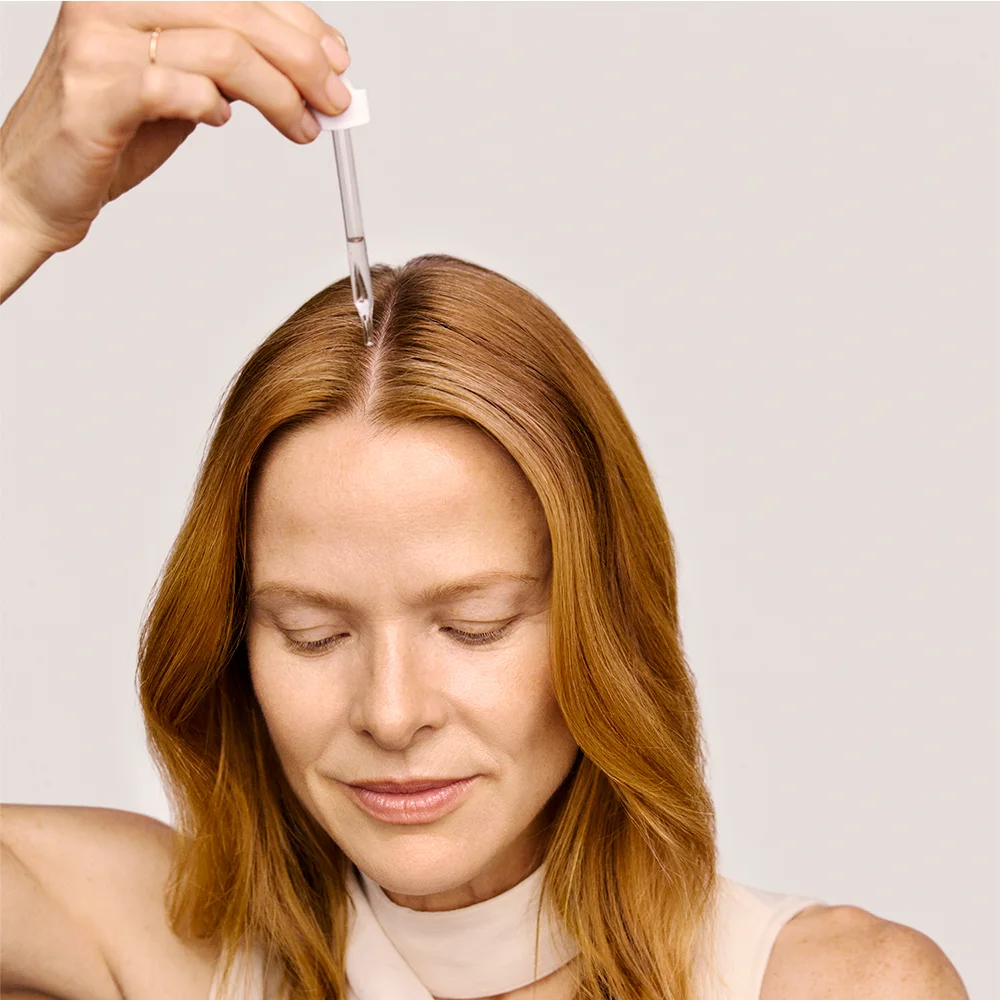Here's what we'll cover
Here's what we'll cover
Menopause is a time of major hormonal changes. Some you might welcome, and others (hot flashes, anyone?) not so much. Another symptom of menopause is hair loss.
Fortunately, there are more options than ever for hormone-induced thinning. Here’s what we know about menopause and hair loss, plus tips for treating it.
What causes menopausal hair loss?
Hair follicles are complex little organs that are continuously changing and growing. Our hair growth cycle is controlled by various hormones and other growth factors in the body (Piérard-Franchimont, 2013).
The average age women start going through menopause is about 49–51. During this time, your body experiences great shifts in hormone levels. Estrogen levels decrease, and androgens (which give rise to male sex hormones) increase. These hormonal changes can also affect hair follicles (Goluch-Koniuszy, 2016; Piérard-Franchimont, 2013).
Hormonal changes can cause hair loss at any point in life, including puberty, after childbirth, and during menopause (Rinaldi, 2016; Piérard-Franchimont, 2013).
The most common type of hair loss in women is androgenetic alopecia or female pattern hair loss. It affects up to 50% of menopausal women (Rinaldi, 2016).
The two major causes of alopecia are androgen levels and genetics. This means if other women in your family experienced hair loss during menopause, you’re also more likely to (Ho, 2021).
What does menopause hair loss look like?
Menopausal hair loss looks different for every person but commonly presents as a wider part and hair thinning on the crown of your head.
This is different from male pattern baldness, which classically presents as a receding hairline at the front and sides, giving the hairline an “M” shape. While hair loss progresses to baldness for many men, this outcome is less likely for women (Murphrey, 2021; Fabbrocini, 2018).
Menopause hair loss treatment and prevention
It can be hard to prevent menopausal hair loss as most cases are genetic. However, there are ways to improve your overall health and stop it from getting worse.
1. Treat underlying health issues
Sometimes, medical problems can contribute to female pattern hair loss, including thyroid problems, autoimmune conditions, and vitamin deficiencies. Working with a healthcare provider to treat any underlying health conditions may stop (and possibly reverse) hair loss (Fabbrocini, 2018).
2. Eat a healthy diet
Diet alone won’t prevent menopausal hair loss, though it can help keep hair follicles healthy and strong. Vitamins, minerals, and other nutrients are vital for cell growth. A poor diet can contribute to hair loss if your body lacks nutrients.
To give your hair follicles what they need to grow, avoid extreme diets and be sure to get enough of the following (Goluch-Koniuszy, 2016; Almohanna, 2019):
3. Low-level laser therapy
A relatively new treatment option is low-level laser therapy (LLLT), which can promote hair regrowth in some people with alopecia.
More research is needed before saying how effective LLLT is, but several devices are already on the market. Laser therapy devices are available as a hand-held comb, hood, or helmet (Fabbrocini, 2018).
4. Medications
Some medications can help with menopausal hair loss. Minoxidil 2% topical solution, also known as Rogaine, is an over-the-counter drug approved for hair regrowth in women.
Minoxidil can take 6–12 months before you start to see results. However, if you stop using minoxidil, hair typically reverts to its previous state (Phillips, 2017).
Spironolactone is a prescription medicine approved to treat fluid retention. It’s also frequently used off-label to treat excess androgens in the body, a cause of female pattern hair loss. Some people experience low blood pressure or electrolyte imbalances on spironolactone, so it’s important to undergo monitoring when you first start taking it (Fabbrocini, 2018).
5. Hair transplant
This route is more costly, but hair transplantation is another option for cosmetic concerns associated with hair loss. This involves a surgeon transferring hair from an area with more hair to spots where hair is sparse. The techniques for transplanting hair have grown much more advanced over the years to achieve a more natural, undetectable look (Fabbrocini, 2018).
What else causes hair loss?
While thinning hair during menopause isn’t unusual, menopause is not the only thing that causes hair loss.
Another common condition is telogen effluvium or hair shedding. This type of hair loss can affect any person regardless of age or gender. People with this condition typically experience temporary hair loss all over the scalp, making hair look thin (Hughes, 2021).
Telogen effluvium is short-lived, typically lasting 1–6 months. It’s typically caused by stress and can also be triggered by (Hughes, 2021):
Hormonal changes
Illness or infection
Certain medications
Poor diet
Here are some other conditions that can cause hair loss (Al Aboud, 2021):
Alopecia areata, an autoimmune condition (this is different than androgenetic alopecia)
Tinea capitis, a type of fungal infection
T, a type of hair loss that results from repetitive tension on the scalp hair
When to see a healthcare professional
Menopausal hair loss can be stressful. If your hair loss is severe or persistent, or you suspect another medical condition is the root cause, it could be helpful to talk to a healthcare professional.
Depending on your goals and circumstances, a healthcare provider can also recommend treatment options shown to help with hair loss, such as medication, laser therapy, or hair transplantation.
DISCLAIMER
If you have any medical questions or concerns, please talk to your healthcare provider. The articles on Health Guide are underpinned by peer-reviewed research and information drawn from medical societies and governmental agencies. However, they are not a substitute for professional medical advice, diagnosis, or treatment.
Al Aboud, A. M. & Zito, P. M. (2021). Alopecia. StatPearls . Retrieved from https://www.ncbi.nlm.nih.gov/books/NBK538178/
Almohanna, H. M., Ahmed, A. A., Tsatalis, J. P., & Tosti, A. (2019). The role of vitamins and minerals in hair loss: a review. Dermatology and Therapy , 9 (1), 51–70. doi:10.1007/s13555-018-0278-6. Retrieved from https://www.ncbi.nlm.nih.gov/pmc/articles/PMC6380979/
Fabbrocini, G., Cantelli, M., Masarà, A., et al. (2018). Female pattern hair loss: A clinical, pathophysiologic, and therapeutic review. International Journal of Women's Dermatology , 4 (4), 203–211. doi:10.1016/j.ijwd.2018.05.001. Retrieved from https://www.ncbi.nlm.nih.gov/pmc/articles/PMC6322157/
Goluch-Koniuszy, Z. S. (2016). Nutrition of women with hair loss problem during the period of menopause. Menopause Review , 15 (1), 56–61. doi:10.5114/pm.2016.58776. Retrieved from https://www.ncbi.nlm.nih.gov/pmc/articles/PMC4828511/
Ho, C. H., Sood, T., & Zito, P. M. (2021). Androgenetic Alopecia. StatPearls . Retrieved from https://www.ncbi.nlm.nih.gov/books/NBK430924/
Hughes, E. C. & Saleh, D. (2021). Telogen Effluvium. StatPearls . Retrieved from https://www.ncbi.nlm.nih.gov/books/NBK430848/
Murphrey, M. B., Agarwal, S., & Zito, P. M. (2021). Anatomy, Hair. StatPearls . Retrieved from https://www.ncbi.nlm.nih.gov/books/NBK513312/
Phillips, T. G., Slomiany, W. P., & Allison, R. (2017). Hair loss: common causes and treatment. American Family Physician , 96 (6), 371–378. Retrieved from https://www.aafp.org/pubs/afp/issues/2017/0915/p371.html
Piérard-Franchimont, C. & Piérard, G. E. (2013). Alterations in hair follicle dynamics in women. BioMed Research International . doi:10.1155/2013/957432. Retrieved from https://www.ncbi.nlm.nih.gov/pmc/articles/PMC3884776/
Rinaldi, S., Bussa, M., & Mascaro, A. (2016). Update on the treatment of androgenetic alopecia. European Review for Medical and Pharmacological Sciences , 20 (1), 54–58. Retrieved from https://pubmed.ncbi.nlm.nih.gov/26813453/












